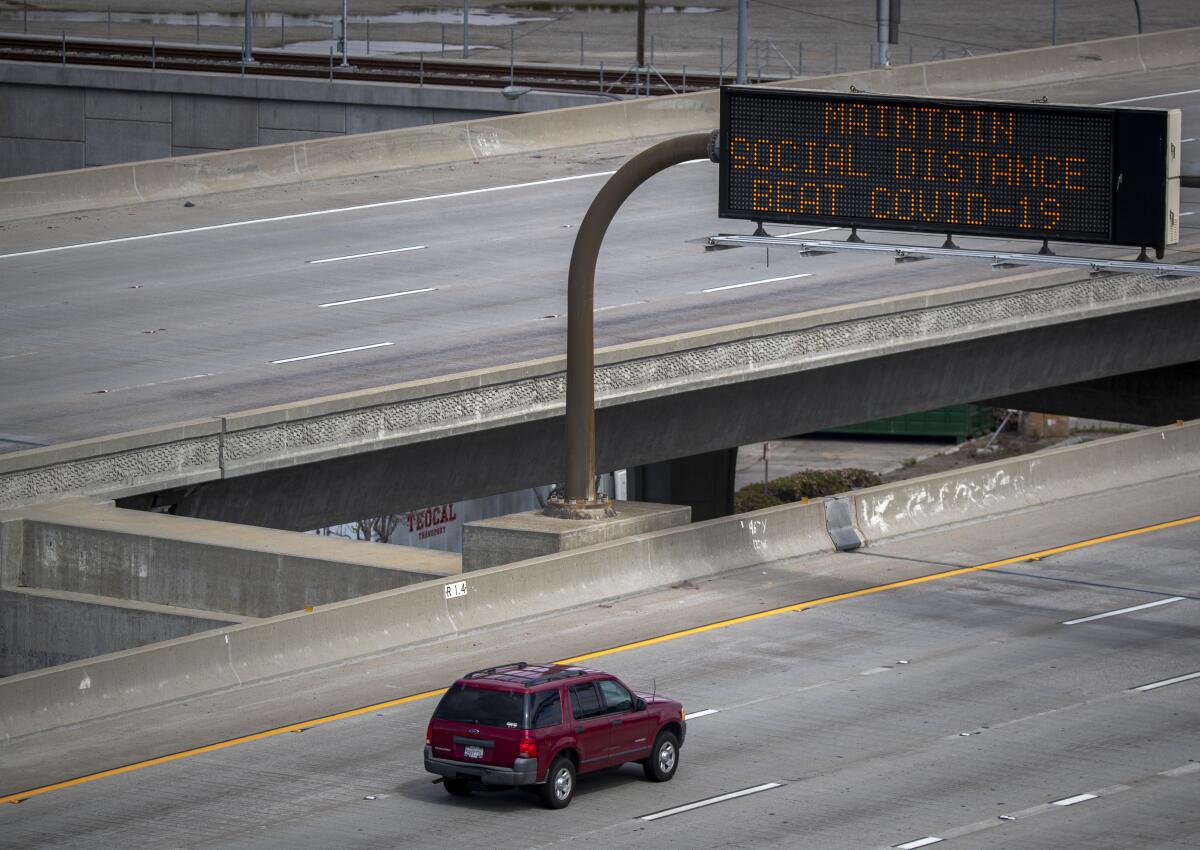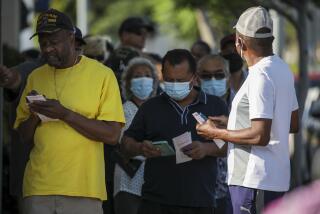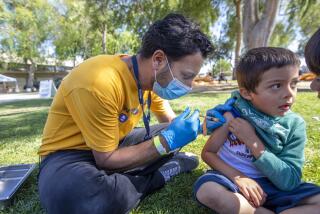As coronavirus spreads, Los Angeles County scores an A in social distancing; other counties lag

- Share via
Freeways once clogged with daily commuters are nearly empty. The windows of bars that were packed with patrons just weeks ago are now boarded up. Sandy stretches of beach lay barren, even on sunny days.
Southern California’s desolate landscape amid the coronavirus outbreak has highlighted people’s unprecedented efforts to restrict their movement and help stem the virus’ spread. Staying at home was somewhat slow to catch on, with people packing beaches, parks and hiking trails in the early days, a move that eventually forced officials to order closures.
“I know it’s hard to have our favorite places — our beaches and hiking trails — closed. But these restrictions will save lives,” Los Angeles Mayor Eric Garcetti tweeted Friday.
But just how much are Californians reducing their travel?
It varies by county, according to an interactive map released last week by Unacast, a New York-based technology company that aims to put a grade on people’s social distancing efforts.
The company’s social distancing scoreboard uses data from millions of anonymous mobile phones to compare the distance that people in each county in the United States traveled before the outbreak began and after it took hold. Areas that observe at least a 40% decrease in average distance traveled are assigned an A grade, while those that show less than a 10% decrease or an increase are given an F, Unacast CEO Thomas Walle wrote in a post on the company’s website.
California, where cases of COVID-19 spiked to more than 7,400 Tuesday, received an A for reducing movement. The company’s data shows Californians overall reduced their average distance traveled by 41% from late February to Thursday.
Los Angeles County also received an A after residents reduced their average distance traveled by 46% from late January to Thursday. Nearby coastal counties, including Orange, San Diego, Ventura and Santa Barbara, where cases have also spiked in recent weeks, received high marks as well.
Hoping to escape the spread of coronavirus, these Californians are fleeing to the deserts and mountains. Some locals wish they had stayed home.
However, the data show disparities between the state’s counties. Some have cut travel significantly, while others have seen an increase.
In Mono County, residents slashed their travel by more than 70% -- the highest reduction in travel statewide. The analysis also found that Bay Area counties were among the biggest travel reducers.
The company’s data also compares the county’s letter grade to the number of new COVID-19 cases reported in an area to help people draw conclusions about social distancing behavior and the spread of the virus over time.
“Our goal in developing this and our COVID-19 Toolkit is to empower organizations to unearth reliable and valuable information to guide critical decision making and planning in relation to COVID-19 containment,” Walle wrote in a statement. “We are updating the Scorecard and enhancing this COVID-19 Toolkit to provide the most timely and accurate information possible, with the hope of ultimately saving lives.”
The data show that counties with more confirmed COVID-19 cases were more likely to reduce their average travel distance than counties with few or no cases.
People in several sparsely populated counties in the northeastern portion of the state, where fewer cases are reported, have actually increased their average distance traveled. Modoc County, which borders Nevada and Oregon and has a population of about 9,000 people, had increased travel 41% as of last week, data show.
Elizabeth Cavasso, chair of the Modoc County Board of Supervisors, said the criteria used in the company’s study may not be applicable to more rural portions of the state where people frequently travel long distances to get takeout or shop at a grocery store.
The county, where agriculture is big business, also still has a lot of people heading to work every day, Cavasso said.
“Traveling long distances is just a way of life here,” she said.
While Modoc County does not have any reported cases of coronavirus, Cavasso said that “a lot of people are staying home and being safe.”
Inland counties in Southern California have also failed to significantly reduce their average travel distance despite an uptick in confirmed coronavirus cases in recent weeks. San Bernardino County residents have reduced their travel by 13% as of Thursday, earning them a D. Riverside County fared slightly better, earning a C after residents reduced their travel by 30%.
Unacast’s study doesn’t draw conclusions about why certain areas have reduced their average distance traveled more than others. Walle noted in a post on the company’s website that simply looking at travel distance doesn’t paint a full picture of social distancing efforts.
The company is working to add layers to its data that will capture more of the complexity of the issue, including exploring how a change in the number of encounters in an area along with the change in the number of locations visited can contribute to an area’s social distancing score.
“Travel distance is one aspect, but of course people can travel far without meeting a soul or travel 50 feet and end up in a crowd — so we know that the real world picture can be quite complex,” Walle wrote.
More to Read
Sign up for Essential California
The most important California stories and recommendations in your inbox every morning.
You may occasionally receive promotional content from the Los Angeles Times.












